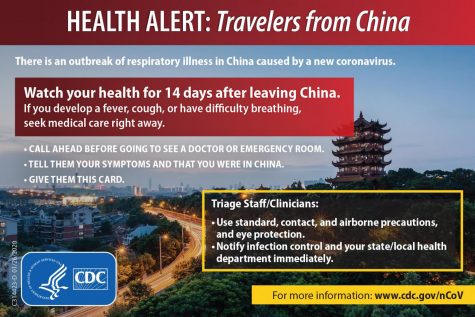What to know about the 2019 novel coronavirus
Provided by the Centers for Disease Control and Prevention
An illustration of the 2019 novel coronavirus, 2019-nCoV, created by the Centers for Disease Control and Prevention.
January 30, 2020
As the 2019 novel coronavirus, 2019-nCoV, continues to spread across the world, Harker Aquila breaks down what you need to know about the outbreak.
What is the 2019-nCoV?
The 2019-nCoV is a respiratory disease that causes respiratory illness, according to the World Health Organization. It belongs in the coronavirus family, which includes viruses such as the common cold as well as the Severe Acute Respiratory Syndrome (SARS) and the Middle East Respiratory Syndrome (MERS).
The CDC has also reported that the outbreak may have originated from a large animal and seafood market in Wuhan.
Chinese and U.S. health authorities have posted the full genome of the virus in medical databases like GenBank and the Global Initiative on Sharing All Influenza Data and to help medical authorities detect the virus.
What are symptoms of the 2019-nCoV?
Common symptoms of the virus include fever, cough and shortness of breath and can take two to 14 days after exposure to appear, according to the CDC. In severe cases, patients may have pneumonia in both lungs.
How are 2019-nCov symptoms different from flu symptoms?
Although both influenza and 2019-nCoV include symptoms such as fever, cough and shortness of breath, the incubation periods of the respective viruses set them apart. According to the CDC, symptoms for 2019-nCoV tend to take effect two to 14 days after first infection. The incubation period for the flu is much shorter – only two to three days.
Due to the similarity of symptoms, influenza and 2019-nCoV would be difficult to tell apart without laboratory testing.
Currently, diagnostic testing for 2019-nCoV can only be done at the CDC, stationed in Atlanta, Georgia.
During the 2018-19 flu season in the U.S., 35.5 million people got sick with the flu, 16.5 million people saw a healthcare provider for the flu and 34,200 people died from the flu, according to the CDC.
How do you treat the virus?
According to the CDC, there is currently no vaccine or specific antiviral treatment for 2019-nCoV. Medical care can help relieve symptoms, and isolation can help limit the virus’ spread.
Dr. YX*, an ENT specialist doctor at a hospital in Wuhan, had been treating patients diagnosed with 2019-nCoV before she was exposed to the virus herself and subsequently put herself in isolation, following hospital requirements.
“The exact method is still being tested to find the best solution,” she said. “Lots of people are still at a stage where the virus symptoms are not extremely severe, but patients showing severe fatal symptoms are people who already have weak immune systems or other diseases related to the respiratory system.”
How do you protect against the virus?
The WHO has published a list of preventative measures that can be taken to minimize risk of infection.
To protect against the virus, the SCCPHD also recommends getting vaccinated for the flu, which can produce similar symptoms; washing hands with liquid soap and water for at least 20 seconds; covering coughs and sneezes with a tissue, sleeve or arm, not a hand; avoiding touching one’s face; staying home if one is sick with any respiratory symptoms and avoiding large groups of people.
While flu vaccines do not protect against 2019-nCov, they can reduce the number of people presenting with similar symptoms as those of the coronavirus, allowing for less confusion.
As of now, flu vaccinations can be found in various locations within a 25 mile radius of the upper school via Sutter Health. Local pharmacies such as CVS and Walmart also offer vaccinations on walk-in notice.
The official website of the CDC recommends prevention steps for people confirmed to have or are being evaluated for 2019-nCoV receiving care at home, prevention steps for caregivers and household members, and prevention steps for close contacts with the virus.
Harker’s Director of Health Services Debra Nott recommended in an email to all Harker parents that families postpone or cancel any plans to travel to China, if possible, echoing the travel advisory issued by the CDC. Nott also recommended that any travelers to China voluntarily quarantine themselves for 14 days upon their return in order to minimize the risk of contagion, and she stressed the importance of washing hands, keeping hands away from the face and staying home if a student has a fever.
How does the virus spread?
The virus can spread from animals to humans, as well as from person to person, though the risk of person-to-person transmission is currently unclear. Officials are still tracking and investigating the outbreak.
At a press conference yesterday, Director of the National Health Committee in China Dr. Ma Xiaowei said that 2019-nCoV can spread from person-to-person during its incubation period, which is the period between exposure to the disease and appearance of symptoms. This is notably different from previous coronaviruses and may be the cause of rising infection rates.
“Observation has shown that the incubation period is contagious,” Dr. Ma said. “The incubation period is around 10 days. The shortest time before the appearance of symptoms was one day. The longest was 14 days. This is very different from SARS.”
The transmission mechanism of the 2019-nCoV is currently unclear. According to the CDC’s fact sheet on the 2019-nCoV, transmission of similar coronaviruses like SARS and MERS occurred between close contacts via respiratory droplets, such as saliva produced in coughs and sneezes. Officials state that transmission may also occur through physical contact with a surface containing the virus, followed by contact with the mouth, nose or eyes.
What should a person do if they think they have been exposed to the virus?
If an individual has recently returned from China or has been in the proximity of someone who may have the 2019-nCoV virus, the CDC recommends that the individual monitor their health closely for the next 14 days. If a fever, coughs or difficulties breathing appear, the individual should see their doctor or go to the nearest hospital immediately.

An information card provided by the CDC and given to all travelers returning from China.
Note: Sources who are identified with an asterisk (*) have been given pseudonyms for the purposes of this article.
Harker Aquila’s interview with Dr. Yu Xu, Xia Zhenguo, Yang Hong and Li Wei were originally conducted in Mandarin and translated to English.
Additional reporting by Emily Tan and Jessie Wang.


















![“[Building nerf blasters] became this outlet of creativity for me that hasn't been matched by anything else. The process [of] making a build complete to your desire is such a painstakingly difficult process, but I've had to learn from [the skills needed from] soldering to proper painting. There's so many different options for everything, if you think about it, it exists. The best part is [that] if it doesn't exist, you can build it yourself," Ishaan Parate said.](https://harkeraquila.com/wp-content/uploads/2022/08/DSC_8149-900x604.jpg)




![“When I came into high school, I was ready to be a follower. But DECA was a game changer for me. It helped me overcome my fear of public speaking, and it's played such a major role in who I've become today. To be able to successfully lead a chapter of 150 students, an officer team and be one of the upperclassmen I once really admired is something I'm [really] proud of,” Anvitha Tummala ('21) said.](https://harkeraquila.com/wp-content/uploads/2021/07/Screen-Shot-2021-07-25-at-9.50.05-AM-900x594.png)







![“I think getting up in the morning and having a sense of purpose [is exciting]. I think without a certain amount of drive, life is kind of obsolete and mundane, and I think having that every single day is what makes each day unique and kind of makes life exciting,” Neymika Jain (12) said.](https://harkeraquila.com/wp-content/uploads/2017/06/Screen-Shot-2017-06-03-at-4.54.16-PM.png)








![“My slogan is ‘slow feet, don’t eat, and I’m hungry.’ You need to run fast to get where you are–you aren't going to get those championships if you aren't fast,” Angel Cervantes (12) said. “I want to do well in school on my tests and in track and win championships for my team. I live by that, [and] I can do that anywhere: in the classroom or on the field.”](https://harkeraquila.com/wp-content/uploads/2018/06/DSC5146-900x601.jpg)
![“[Volleyball has] taught me how to fall correctly, and another thing it taught is that you don’t have to be the best at something to be good at it. If you just hit the ball in a smart way, then it still scores points and you’re good at it. You could be a background player and still make a much bigger impact on the team than you would think,” Anya Gert (’20) said.](https://harkeraquila.com/wp-content/uploads/2020/06/AnnaGert_JinTuan_HoHPhotoEdited-600x900.jpeg)

![“I'm not nearly there yet, but [my confidence has] definitely been getting better since I was pretty shy and timid coming into Harker my freshman year. I know that there's a lot of people that are really confident in what they do, and I really admire them. Everyone's so driven and that has really pushed me to kind of try to find my own place in high school and be more confident,” Alyssa Huang (’20) said.](https://harkeraquila.com/wp-content/uploads/2020/06/AlyssaHuang_EmilyChen_HoHPhoto-900x749.jpeg)














